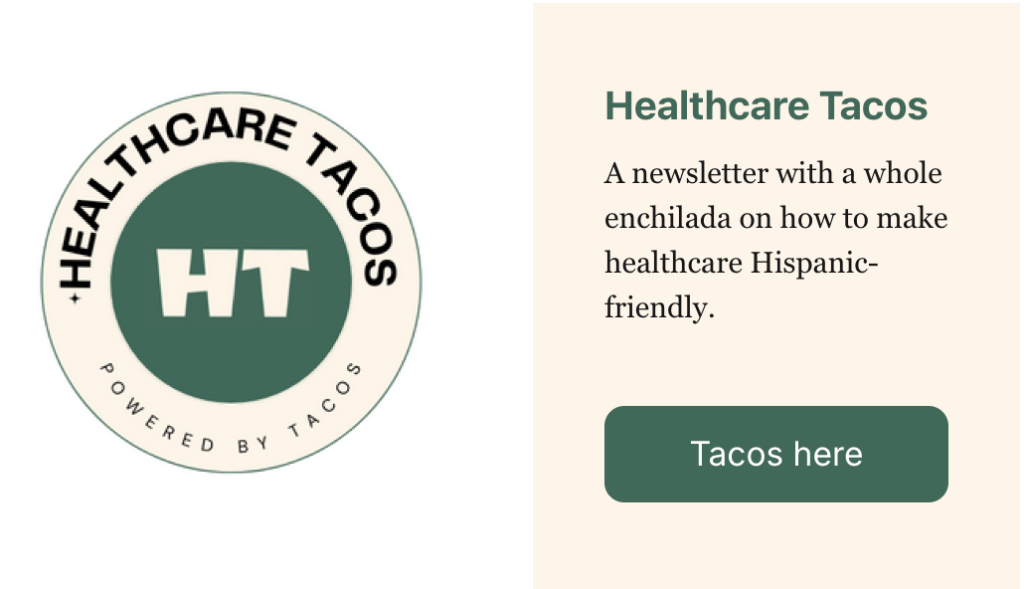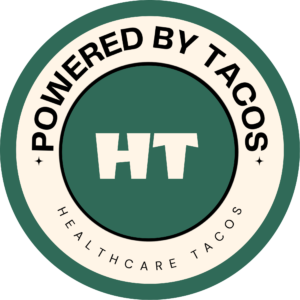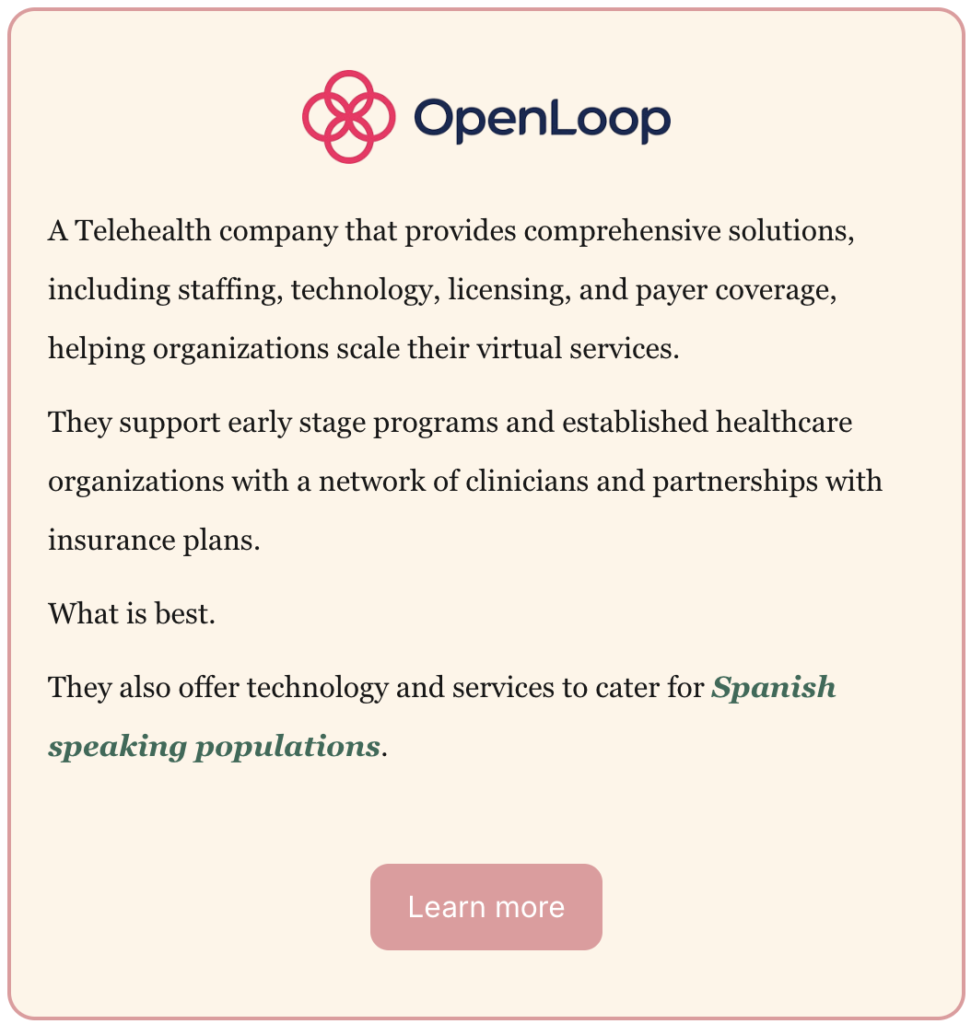

Amig@s – let’s talk about Hispanic patients.
We all know the challenges of healthcare.
So, I wanted to start today with a question for you all. Are we truly doing enough to ensure Hispanic patients feel supported?
I’d say we’re missing a few key ingredients.
And I wish I had a magic wand to make healthcare Hispanic friendly in one second.
Would you believe me?
If I told you that MILLIONS of Hispanics are falling through the cracks in our healthcare system every day?
I’m sure this is NOT news to you, but it’s something we must solve.
And to be able to do this.
We can NOT keep serving the same old menu of outdated strategies and expect everyone to be supported.
Which is why, in this edition.
I will help you spice your approach to make healthcare more accessible to Hispanic patients in your market territory.
First, let me introduce a great company that can help with your Spanish efforts.
Now, Let’s taco ‘bout our enchilada.
Amig@s –
We all know the challenges of healthcare.
So, I wanted to start today with a question for you all. Are we truly doing enough to ensure Hispanics feel supported?
I’d say we’re missing a few key ingredients.
And I wish I had a magic wand to make healthcare Hispanic friendly in one second.
Would you believe me?
If I told you that MILLIONS of Hispanics are falling through the cracks in our healthcare system every day?
I’m sure this is NOT news to you, but it’s something we must solve.
And to be able to do this.
We can NOT keep serving the same old menu of outdated strategies and expect everyone to be supported.
Which is why, in this edition.
I will help you spice your approach to make healthcare more accessible to Hispanics in your market territory.
First, let me introduce a great company that can help with your Spanish efforts.
Now, Let’s taco ‘bout our enchilada.
![]()
Three Insights 🌶️
I. Speak Their Language
Let’s take this example; many of you have done this before.
Imagine you are in Cancun, Mexico, needing medical care but, of course, unable to fully understand your doctor.
I’m sure your anxiety would likely skyrocket, right?
Now, think about millions of Hispanic patients who experience this every single day when they can NOT communicate at a moment of sickness.
Please note.
This is NOT just about offering translation services.
It’s about meeting my community where they are, whether in Spanish or Spanglish.
Yes, I said Spanglish.
Because communication is the foundation of trust.
So, when patients can express their concerns in a language they are comfortable with, they feel heard and respected.
Of course, reducing stress and opening the door for honest, transparent conversations about their health.
Isn’t this what we all want?
Sooo, remember this.
The point of speaking their language is NOT just about “TALKING”; it’s, in fact, about truly “CONNECTING.”
You can read more about it here.
II. Create a Digital Front Door
Your website, or social media is often the first place Hispanic patients go to learn about your services.
This needs to be welcoming.
Oh, and you already do this for your current audience, so it’s time to adjust your strategy for Hispanics by making it culturally relevant.
Not sure how?
Tell your team to subscribe to Healthcare Tacos for insights, actionable steps, and advice.

Now, since I’m done with the Healthcare tacos AD.
Let’s continue with this enchilada.
Remember to ensure your digital presence is bilingual and culturally sensitive for my community to feel seen and understood from the moment they arrive seeking your services.
Here you can start by updating your website, social media, and forms to be easy to navigate and relatable for them.
But, take it a step further.
Create a 100% Spanish operation and add content 100% in Spanish with culturally relevant images, so that from the moment they arrive, they feel home.
Oh, and avoid relying on basic translation services at all costs, and create a truly personalized experience.
If not, I will delete your email from this list. Joking
III. Execute Relevant Strategies
When engaging Hispanic patients.
The goal is NOT just translating “See a doctor now” into Spanish.
It’s about crafting content that resonates on a deeper level.
Therefore, your “Spanish” go-to-market (GTM) strategy should focus on finding common ground, creating authentic messaging, and addressing the real needs of the community.
So, offer content that excites them.
Whether it’s wellness tips, culturally relevant health advice, or community events.
Oh, and please avoid generic ads that no one likes.
Now, when you meet Hispanic patient where they are with thoughtful, relevant messaging, they are far more likely to trust and engage with your services.
That’s where the magic is; that’s how it simply works.
Here’s an example from Unividoc, a company I created a few years back, which helped thousands of Hispanics across the U.S. and LATAM.
This video alone generated over 10,000+ leads, with around 70% converting into paying patients.
The impact speaks for itself.
Insights
I. Speak Their Language
Let’s take this example; many of you have done this before.
Imagine you are in Cancun, Mexico, needing medical care but, of course, unable to fully understand your doctor.
I’m sure your anxiety would likely skyrocket, right?
Now, think about millions of Hispanics who experience this every single day when they can NOT communicate at a moment of sickness.
Please note.
This is NOT just about offering translation services.
It’s about meeting my community where they are, whether in Spanish or Spanglish.
Yes, I said Spanglish.
Because communication is the foundation of trust.
So, when patients can express their concerns in a language they are comfortable with, they feel heard and respected.
Of course, reducing stress and opening the door for honest, transparent conversations about their health.
Isn’t this what we all want?
Sooo, remember this.
The point of speaking their language is NOT just about “TALKING”; it’s, in fact, about truly “CONNECTING.”
You can read more about it here.
II. Create a Digital Front Door
Your website, or social media is often the first place Hispanic patients go to learn about your services.
This needs to be welcoming.
Oh, and you already do this for your current audience, so it’s time to adjust your strategy for Hispanics by making it culturally relevant.
Not sure how?
Tell your team to subscribe to Healthcare Tacos for insights, actionable steps, and advice.

Now, since I’m done with the Healthcare tacos AD.
Let’s continue with this enchilada.
Remember to ensure your digital presence is bilingual and culturally sensitive for my community to feel seen and understood from the moment they arrive seeking your services.
Here you can start by updating your website, social media, and forms to be easy to navigate and relatable for them.
But, take it a step further.
Create a 100% Spanish operation and add content 100% in Spanish with culturally relevant images, so that from the moment they arrive, they feel home.
Oh, and avoid relying on basic translation services at all costs, and create a truly personalized experience.
If not, I will delete your email from this list. Joking
III. Execute Relevant Strategies
When engaging Hispanic patients.
The goal is NOT just translating “See a doctor now” into Spanish.
It’s about crafting content that resonates on a deeper level.
Therefore, your “Spanish” go-to-market (GTM) strategy should focus on finding common ground, creating authentic messaging, and addressing the real needs of the community.
So, offer content that excites them.
Whether it’s wellness tips, culturally relevant health advice, or community events.
Oh, and please avoid generic ads that no one likes.
Now, when you meet patients where they are with thoughtful, relevant messaging, they are far more likely to trust and engage with your services.
That’s where the magic is; that’s how it simply works.
Here’s an example from Unividoc, a company I created a few years back, which helped thousands of Hispanics across the U.S. and LATAM.
This video alone generated over 10,000+ leads, with around 70% converting into paying patients.
The impact speaks for itself.
![]()
Two Actionable Steps 🌮
I. Go Beyond Training
As I mentioned in my previous edition Hispanic Heritage Month, should be a long year enchilada.
Cultural competency isn’t a checkbox; it’s an ongoing journey.
Do NOT rely just on annual training.
Instead, aim for cultural fluency by embedding education into your organization’s daily culture.
Create immersive workshops with live interactions, role playing, and real life scenarios.
What is best?
Encourage your staff to ask questions, practice difficult conversations, and engage with Hispanic communities in meaningful ways.
Now, incorporating Hispanic voices into your decision making process is just as crucial.
Therefore, invite community leaders, healthcare workers, or even patients themselves to offer insights and provide feedback on how your services can better align with their needs.
Here is the possible outcome.
When their perspectives shape your strategies, the connection becomes more authentic.
Lastly, remember that cultural fluency is more than just understanding traditions or customs.
It’s about creating an environment where Hispanics feel seen and valued.
This commitment to inclusivity builds trust, improves patient outcomes, and creates a stronger bond between your organization and the community.
II. Make Your Space Welcoming
Your healthcare environment should feel like home to Hispanics from the moment they walk through the door, whether in person or digitally.
Remember.
It’s not just about putting up bilingual signs; it’s about demonstrating a genuine commitment to inclusivity in every aspect.
Here is one key step to move forward with.
Ensuring your front desk staff speaks Spanish and offers a warm, welcoming greeting, not just a transactional one.
Here is something simple organizations miss.
Be prepared from the start so you won’t be scrambling looking for a translator.
Also, incorporate culturally relevant artwork and decorations that reflect Hispanic traditions but beyond the aesthetics, design clear, simple communication materials in Spanish.
This is not a brainer when it comes to improving accessibility.
Now, if you truly want to raise the bar and change the status quo.
Consider crafting every step of the patient journey 100% in Spanish, making each interaction more meaningful.
Finally, do NOT overlook your Spanish digital front door, such as websites, apps, and patient portals.
Actionable Steps
I. Go Beyond Training
As I mentioned in my previous edition Hispanic Heritage Month, should be a long year enchilada.
Cultural competency isn’t a checkbox; it’s an ongoing journey.
Do NOT rely just on annual training.
Instead, aim for cultural fluency by embedding education into your organization’s daily culture.
Create immersive workshops with live interactions, role playing, and real life scenarios.
What is best?
Encourage your staff to ask questions, practice difficult conversations, and engage with Hispanic communities in meaningful ways.
Now, incorporating Hispanic voices into your decision making process is just as crucial.
Therefore, invite community leaders, healthcare workers, or even patients themselves to offer insights and provide feedback on how your services can better align with their needs.
Here is the possible outcome.
When their perspectives shape your strategies, the connection becomes more authentic.
Lastly, remember that cultural fluency is more than just understanding traditions or customs.
It’s about creating an environment where Hispanics feel seen and valued.
This commitment to inclusivity builds trust, improves patient outcomes, and creates a stronger bond between your organization and the community.
II. Make Your Space Welcoming
Your healthcare environment should feel like home to Hispanics from the moment they walk through the door, whether in person or digitally.
Remember.
It’s not just about putting up bilingual signs; it’s about demonstrating a genuine commitment to inclusivity in every aspect.
Here is one key step to move forward with.
Ensuring your front desk staff speaks Spanish and offers a warm, welcoming greeting, not just a transactional one.
Here is something simple organizations miss.
Be prepared from the start so you won’t be scrambling looking for a translator.
Also, incorporate culturally relevant artwork and decorations that reflect Hispanic traditions but beyond the aesthetics, design clear, simple communication materials in Spanish.
This is not a brainer when it comes to improving accessibility.
Now, if you truly want to raise the bar and change the status quo.
Consider crafting every step of the patient journey 100% in Spanish, making each interaction more meaningful.
Finally, do NOT overlook your Spanish digital front door, such as websites, apps, and patient portals.
![]()
One Piece of Advice 💃
I. Start Small, but Start Now
Here is my honest point.
Inclusivity does NOT have to be overwhelming or require a massive overhaul.
The truth.
You can start with small, manageable steps without the perfect strategy.
This could be adding bilingual staff at the front desk, offering culturally relevant guides, or simply organizing your first cultural workshop.
What truly matters is that each small action creates momentum.
And over time small efforts will build on one another, creating a more inclusive environment.
Remember, the most important thing here is to take that first step today.
Since meaningful change happens gradually, and every small improvement leads to a more inclusive future.
Piece of Advice
I. Start Small, but Start Now
Here is my honest point.
Inclusivity does NOT have to be overwhelming or require a massive overhaul.
The truth.
You can start with small, manageable steps without the perfect strategy.
This could be adding bilingual staff at the front desk, offering culturally relevant guides, or simply organizing your first cultural workshop.
What truly matters is that each small action creates momentum.
And over time small efforts will build on one another, creating a more inclusive environment.
Remember, the most important thing here is to take that first step today.
Since meaningful change happens gradually, and every small improvement leads to a more inclusive future.
![]()





